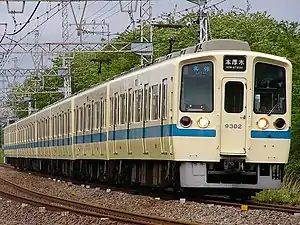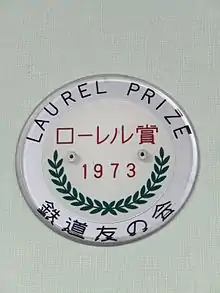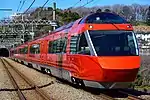| Odakyu 9000 series | |
|---|---|
 A 9000 series train in May 2004 | |
| In service | 1972–2006 |
| Manufacturer | Tokyu Car, Kawasaki Heavy Industries |
| Constructed | 1972–1977 |
| Scrapped | 2005–2006 |
| Number built | 90 vehicles (18 sets) |
| Number in service | None |
| Number preserved | 1 vehicle |
| Formation | 4 / 6 cars per set |
| Operators | Odakyu Electric Railway |
| Specifications | |
| Width | 2,870 mm (9 ft 5 in) |
| Doors | 4 pairs per side |
| Maximum speed | 100 km/h (62 mph) (service) 120 km/h (75 mph) (design) |
| Traction system | Mitsubishi resistor control with field chopper control (thyristor switching device[1])(electric camshaft); 11 steps in series, 8 steps in parallel, field weakening (chopper-controlled), 19 steps for dynamic braking and 11 steps for regenerative braking |
| Traction motors | Mitsubishi DC compound motor[2] |
| Power output | 110 kW x4 per motored car |
| Electric system(s) | 1,500 V DC overhead lines |
| Current collector(s) | Pantograph |
| Bogies | FS085, FS385[3] |
| Braking system(s) | Regenerative braking, dynamic braking |
| Multiple working | 2600 Series/4000 Series(1st generation)/5000 Series(1st generation)/8000 Series/1000 Series/3000 series |
| Track gauge | 1,067 mm (3 ft 6 in) |
The Odakyu 9000 series (小田急9000形, Odakyū 9000-gata) was a commuter electric multiple unit (EMU) train type operated by the private railway operator Odakyu Electric Railway in Japan from 1972 until 2006.
Technical specifications
The trains were equipped with 110 kW motors and chopper control.[4]
Formations
The fleet consisted of nine four-car and nine six-car sets.[5] The sets were formed as follows.[6]
- Four-car sets
| Designation | M1c | M1 | M2 | M2c |
|---|---|---|---|---|
| Numbering | 9000 | 9100 | 9200 | 9300 |
- Six-car sets
| Designation | M1c | M2 | T1 | T2 | M1 | M2c |
|---|---|---|---|---|---|---|
| Numbering | 9400 | 9500 | 9550 | 9650 | 9600 | 9700 |
History
The trains entered service in 1972, and were the recipient of the 1973 Laurel Prize.[7] Chiyoda Line through services with 9000 series trains began on March 31, 1978.[6] The trains were withdrawn from service in March 2006.[5] A farewell run between Hadano and Karakida was operated on May 13, 2006.[6]
 Laurel Prize 1973 plaque
Laurel Prize 1973 plaque First Odakyu and Chiyoda Line through-services on March 31, 1978
First Odakyu and Chiyoda Line through-services on March 31, 1978 9000 series (left) with "Sayonara" headboard on May 13, 2006
9000 series (left) with "Sayonara" headboard on May 13, 2006
Preserved examples
- Deha 9001: stored at the Kitami inspection facility[4]
Derivatives
Trains of a similar design operate on the Roca Line in Argentina.
References
- ↑ "小田急車両のすべて" [All About ODAKYU's Electric Cars]. June 1, 1996.
- ↑ 『鉄道ピクトリアル』通巻679号 p.231
- ↑ "FS385 FS085 / 小田急電鉄9000形" [FS385 FS085 / Odakyu Electric Railway 9000 series]. rail.hobidas.com. Neko Publishing. May 15, 2006. Archived from the original on November 21, 2019. Retrieved November 28, 2019.
- 1 2 Ubukata, Yoshio; Kazuhide, Onuma (2014). 小田急通勤型電車のあゆみ [Odakyu commuter train history] (in Japanese). Jtb Publishing. pp. 64–68. ISBN 9784533100178.
- 1 2 "小田急9000形" [Odakyu 9000 series]. rail.hobidas.com. Neko Publishing. August 10, 2006. Archived from the original on November 21, 2019. Retrieved November 27, 2019.
- 1 2 3 "小田急電鉄9000形ミニ・ディテールファイル その9" [Odakyu Electric Railway 9000 series mini detail file 9]. rail.hobidas.com. Neko Publishing. May 15, 2006. Archived from the original on November 21, 2019. Retrieved November 27, 2019.
Wikimedia Commons has media related to Odakyu 9000 series.
This article is issued from Wikipedia. The text is licensed under Creative Commons - Attribution - Sharealike. Additional terms may apply for the media files.
